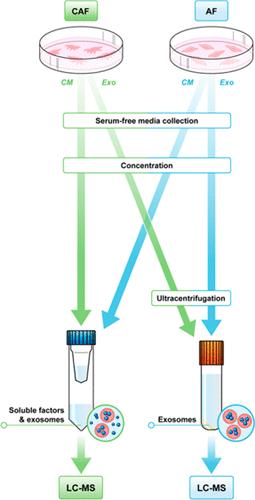当前位置:
X-MOL 学术
›
J. Proteome Res.
›
论文详情
Our official English website, www.x-mol.net, welcomes your
feedback! (Note: you will need to create a separate account there.)
Proteomic Analysis of Cancer-Associated Fibroblasts Reveals a Paracrine Role for MFAP5 in Human Oral Tongue Squamous Cell Carcinoma
Journal of Proteome Research ( IF 3.8 ) Pub Date : 2018-05-02 , DOI: 10.1021/acs.jproteome.7b00925 Simona Principe 1 , Salvador Mejia-Guerrero 1 , Vladimir Ignatchenko 1 , Ankit Sinha 2 , Alexandr Ignatchenko 1 , Willa Shi 3 , Keira Pereira 2 , Susie Su 1, 4 , Shao Hui Huang 3 , Brian O’Sullivan 3 , Wei Xu 1, 4 , David P. Goldstein 1, 5, 6 , Ilan Weinreb 1, 7 , Laurie Ailles 1, 2 , Fei-Fei Liu 1, 2, 3 , Thomas Kislinger 1, 2
Journal of Proteome Research ( IF 3.8 ) Pub Date : 2018-05-02 , DOI: 10.1021/acs.jproteome.7b00925 Simona Principe 1 , Salvador Mejia-Guerrero 1 , Vladimir Ignatchenko 1 , Ankit Sinha 2 , Alexandr Ignatchenko 1 , Willa Shi 3 , Keira Pereira 2 , Susie Su 1, 4 , Shao Hui Huang 3 , Brian O’Sullivan 3 , Wei Xu 1, 4 , David P. Goldstein 1, 5, 6 , Ilan Weinreb 1, 7 , Laurie Ailles 1, 2 , Fei-Fei Liu 1, 2, 3 , Thomas Kislinger 1, 2
Affiliation

|
Bidirectional communication between cells and their microenvironment is crucial for both normal tissue homeostasis and tumor growth. During the development of oral tongue squamous cell carcinoma (OTSCC), cancer-associated fibroblasts (CAFs) create a supporting niche by maintaining a bidirectional crosstalk with cancer cells, mediated by classically secreted factors and various nanometer-sized vesicles, termed as extracellular vesicles (EVs). To better understand the role of CAFs within the tumor stroma and elucidate the mechanism by which secreted proteins contribute to OTSCC progression, we isolated and characterized patient-derived CAFs from resected tumors with matched adjacent tissue fibroblasts (AFs). Our strategy employed shotgun proteomics to comprehensively characterize the proteomes of these matched fibroblast populations. Our goals were to identify CAF-secreted factors (EVs and soluble) that can functionally modulate OTSCC cells in vitro and to identify novel CAF-associated biomarkers. Comprehensive proteomic analysis identified 4247 proteins, the most detailed description of a pro-tumorigenic stroma to date. We demonstrated functional effects of CAF secretomes (EVs and conditioned media) on OTSCC cell growth and migration. Comparative proteomics identified novel proteins associated with a CAF-like state. Specifically, MFAP5, a protein component of extracellular microfibrils, was enriched in CAF secretomes. Using in vitro assays, we demonstrated that MFAP5 activated OTSCC cell growth and migration via activation of MAPK and AKT pathways. Using a tissue microarray of richly annotated primary human OTSCCs, we demonstrated an association of MFAP5 expression with patient survival. In summary, our proteomics data of patient-derived stromal fibroblasts provide a useful resource for future mechanistic and biomarker studies.
中文翻译:

蛋白质组学分析癌症相关的成纤维细胞揭示了MFAP5在人口腔舌鳞状细胞癌中的旁分泌作用。
细胞及其微环境之间的双向通讯对于正常组织动态平衡和肿瘤生长均至关重要。在口腔鳞状细胞癌(OTSCC)的发展过程中,与癌症相关的成纤维细胞(CAF)通过维持与癌细胞的双向串扰来创造支撑位,这种串扰是由经典分泌因子和各种纳米大小的囊泡(称为细胞外囊泡)介导的(电动汽车)。为了更好地了解CAF在肿瘤基质中的作用,并阐明分泌蛋白促成OTSCC进展的机制,我们从与匹配的相邻组织成纤维细胞(AFs)切除的肿瘤中分离并鉴定了患者来源的CAF。我们的策略采用shot弹枪蛋白质组学来全面表征这些匹配的成纤维细胞群体的蛋白质组。我们的目标是鉴定可以在体外功能性调节OTSCC细胞的CAF分泌因子(EV和可溶性),并鉴定出与CAF相关的新型生物标记。全面的蛋白质组学分析鉴定出4247种蛋白质,这是迄今为止致癌基质的最详细描述。我们证明了CAF分泌组(EV和条件培养基)对OTSCC细胞生长和迁移的功能作用。比较蛋白质组学鉴定了与CAF样状态相关的新型蛋白质。具体而言,MFAP5是细胞外微纤维的蛋白质成分,富含CAF分泌组。使用体外测定,我们证明了MFAP5通过激活MAPK和AKT途径激活了OTSCC细胞的生长和迁移。使用富含注释的原代人OTSCC的组织芯片,我们证明了MFAP5表达与患者生存率的相关性。总之,我们的患者源性基质成纤维细胞的蛋白质组学数据为将来的机理和生物标记研究提供了有用的资源。
更新日期:2018-05-03
中文翻译:

蛋白质组学分析癌症相关的成纤维细胞揭示了MFAP5在人口腔舌鳞状细胞癌中的旁分泌作用。
细胞及其微环境之间的双向通讯对于正常组织动态平衡和肿瘤生长均至关重要。在口腔鳞状细胞癌(OTSCC)的发展过程中,与癌症相关的成纤维细胞(CAF)通过维持与癌细胞的双向串扰来创造支撑位,这种串扰是由经典分泌因子和各种纳米大小的囊泡(称为细胞外囊泡)介导的(电动汽车)。为了更好地了解CAF在肿瘤基质中的作用,并阐明分泌蛋白促成OTSCC进展的机制,我们从与匹配的相邻组织成纤维细胞(AFs)切除的肿瘤中分离并鉴定了患者来源的CAF。我们的策略采用shot弹枪蛋白质组学来全面表征这些匹配的成纤维细胞群体的蛋白质组。我们的目标是鉴定可以在体外功能性调节OTSCC细胞的CAF分泌因子(EV和可溶性),并鉴定出与CAF相关的新型生物标记。全面的蛋白质组学分析鉴定出4247种蛋白质,这是迄今为止致癌基质的最详细描述。我们证明了CAF分泌组(EV和条件培养基)对OTSCC细胞生长和迁移的功能作用。比较蛋白质组学鉴定了与CAF样状态相关的新型蛋白质。具体而言,MFAP5是细胞外微纤维的蛋白质成分,富含CAF分泌组。使用体外测定,我们证明了MFAP5通过激活MAPK和AKT途径激活了OTSCC细胞的生长和迁移。使用富含注释的原代人OTSCC的组织芯片,我们证明了MFAP5表达与患者生存率的相关性。总之,我们的患者源性基质成纤维细胞的蛋白质组学数据为将来的机理和生物标记研究提供了有用的资源。











































 京公网安备 11010802027423号
京公网安备 11010802027423号